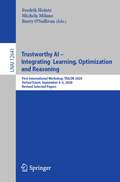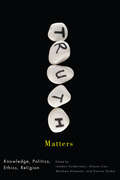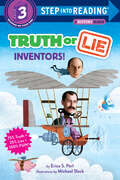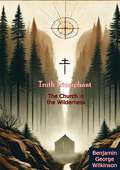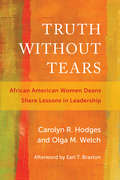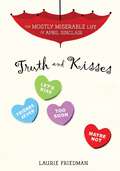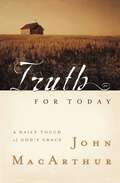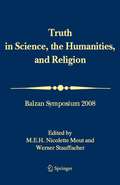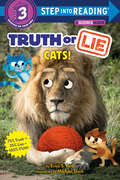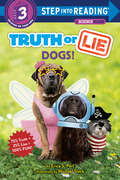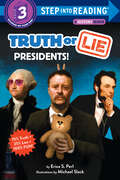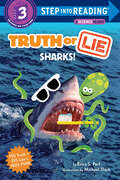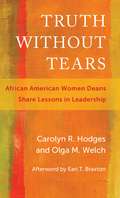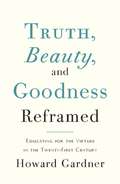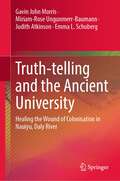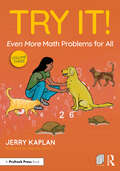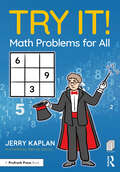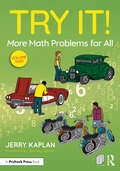- Table View
- List View
Trusting in Higher Education: A multifaceted discussion of trust in and for higher education in Norway and the United Kingdom (Higher Education Dynamics #57)
by Peter Maassen Paul GibbsThis multidisciplinary book brings together scholars from Norway and the UK to discuss the notion of trust within the structures and forms of higher education located in two distinctive localities. The meaning of trust is multi-variant and nuanced, but is omnipresent in the literature on higher education ranging from student engagement to policy exhortations. A key feature of this book is the effort to integrate the term ‘trust’ conceptually, functionally and phenomenological more generally as well as within the context of higher education. Practice from within Norway and the UK is used to illustrate and expose relevant similarities and varieties in trust and the (possible) lack of it within the sector. The book thus faces the complexity of trust and its distinctive manifestation through a number of analytical lenses and realities.
Trustworthy AI - Integrating Learning, Optimization and Reasoning: First International Workshop, TAILOR 2020, Virtual Event, September 4–5, 2020, Revised Selected Papers (Lecture Notes in Computer Science #12641)
by Michela Milano Barry O’Sullivan Fredrik HeintzThis book constitutes the thoroughly refereed conference proceedings of the First International Workshop on the Foundation of Trustworthy AI - Integrating Learning, Optimization and Reasoning, TAILOR 2020, held virtually in September 2020, associated with ECAI 2020, the 24th European Conference on Artificial Intelligence. The 11 revised full papers presented together with 6 short papers and 6 position papers were reviewed and selected from 52 submissions. The contributions address various issues for Trustworthiness, Learning, reasoning, and optimization, Deciding and Learning How to Act, AutoAI, and Reasoning and Learning in Social Contexts.
Truth Decay: An Initial Exploration of the Diminishing Role of Facts and Analysis in American Public Life
by Michael D. Rich KavanaghPolitical and civil discourse in the United States is characterized by “Truth Decay,” defined as increasing disagreement about facts, a blurring of the line between opinion and fact, an increase in the relative volume of opinion compared with fact, and lowered trust in formerly respected sources of factual information. This report explores the causes and wide-ranging consequences of Truth Decay and proposes strategies for further action.
Truth Matters: Knowledge, Politics, Ethics, Religion
by Lambert Zuidervaart Allyson Carr Ronnie Shuker Matthew J. KlaassenWhy should we seek and tell the truth? Does anyone know what truth is? Many are skeptical about the relevance of truth. Truth Matters endeavours to show why truth is important in a world where the very idea of truth is contested. Putting philosophers in conversation with educators, literary scholars, physicists, political theorists, and theologians, Truth Matters ranges across both analytic and continental philosophy and draws on the ideas of thinkers such as Aquinas, Balthasar, Brandom, Davidson, Dooyeweerd, Gadamer, Habermas, Kierkegaard, Plantinga, Ricoeur, and Wolterstorff. Some essays attempt to provide a systematic account of truth, while others wrestle with the question of how truth is told and what it means to live truthfully. Contributors address debates between realists and anti-realists, explore issues surrounding relativism and constructivism in education and the social sciences, examine the politics of truth telling and the ethics of authenticity, and consider various religious perspectives on truth. Most scholars agree that truth is propositional, being expressed in statements that are subject to proof or disproof. This book goes a step farther: yes, propositional truth is important, but truth is more than propositional. To recognize how it is more than propositional is crucial for understanding why truth truly matters. Contributors include Doug Blomberg (ICS), Allyson Carr (ICS), Jeffrey Dudiak (King’s University College), Olaf Ellefson (York University), Gerrit Glas (VU University Amsterdam), Gill K. Goulding (Regis College), Jay Gupta (Mills College), Clarence Joldersma (Calvin College), Matthew J. Klaassen (ICS), John Jung Park (Duke University), Pamela J. Reeve (St. Augustine’s Seminary), Amy Richards (World Affairs Council of Western Michigan), Calvin Seerveld (ICS), Ronnie Shuker (ICS), Adam Smith (Brandeis University), John Van Rys (Redeemer University College), Darren Walhof (Grand Valley State University), Matthew Walhout (Calvin College), and Lambert Zuidervaart (ICS).
Truth Or Lie: Inventors! (Step into Reading)
by Erica S. PerlBudding inventors and science fair nerds will love hunting down the TRUTH about some groundbreaking inventions--past and present--and the people behind them in this innovative early reader.The computer mouse was invented by Steve Jobs, right? That's a LIE! The TRUTH is, it was invented by a man you've probably never heard of named Doug Englebart!! Though this engaging early reader is 100% fun, 25% of it is FALSE! In a unique Q&A format, proficient readers are quizzed about inventions and their inventors to see if they can separate facts from "lies." The book's mascot--the Truth Sleuth--guides readers through this funny and fact-packed book, which features photos and illustrations of a wide variety of inventions--from the printing press to velcro to a light-up soccer ball. With funny, kid-appealing art by Michael Slack.Step 3 Readers feature easy-to-follow plots about popular topics, for children who are ready to read on their own.
Truth Triumphant: The Church in the Wilderness - A Christian History from Apostolic Times to Modernity
by Benjamin George WilkinsonTruth Triumphant: The Church in the Wilderness by Benjamin George Wilkinson is a historical and theological exploration of the survival and perseverance of God’s faithful remnant throughout the ages. First published in the 20th century, this work offers a comprehensive narrative of how the true church, despite persecution and trials, preserved its faith and doctrines during centuries of religious upheaval and spiritual darkness.Wilkinson presents the concept of the “church in the wilderness” as a symbol for believers who remained committed to biblical truth in opposition to mainstream religious institutions. From the early Christian era, through the rise of Roman Catholicism, and into the Reformation, Wilkinson traces the history of these often-overlooked communities. He highlights the role of groups such as the Waldensians, Albigensians, and Celtic Christians, who safeguarded biblical principles while resisting doctrinal compromise and external oppression.The book also delves into key theological issues such as Sabbath observance, scriptural authority, and the ongoing battle between truth and error. Wilkinson portrays the survival of these believers as a testimony to divine guidance and the ultimate triumph of truth over deception. He argues that these historical movements laid the foundation for later religious reforms and contributed to the revival of biblical Christianity.Written with passion and conviction, Truth Triumphant emphasizes the importance of faithfulness and endurance in the face of opposition. It offers a thought-provoking perspective on church history, one that underscores the idea that true faith often flourishes in the margins, away from the centers of power.For readers interested in church history, theology, or religious movements, Truth Triumphant provides an inspiring account of spiritual resilience and the triumph of truth through the centuries. Wilkinson’s work invites readers to reflect on the ongoing relevance of these struggles in the modern world, reminding believers of the importance of faith and perseverance.
Truth Without Tears: African American Women Deans Share Lessons in Leadership (Race and Education)
by Carolyn R. Hodges Olga M. WelchTruth Without Tears is a timely and insightful portrait of Black women leaders in American colleges and universities. Carolyn R. Hodges and Olga M. Welch are former deans who draw extensively on their experience as African American women to account for both the challenges and opportunities facing women of color in educational leadership positions. Hodges and Welch deftly combine autobiography with more general information and observations to fashion an interesting and helpful book about higher education leadership. They offer their perspectives on being the first deans of color in two predominately white institutions in an effort to fill a gap that exists in the literature on deanships in higher education. Each chapter offers reflections or examples of the authors&’ particular experiences that have taught them how to become effective leaders. The book engages readers to consider ways of learning how to balance the need for action with &“deliberative and deliberate approaches&” that are grounded in maintaining decisiveness, accountability, and allegiance to organizational goals, especially those that support inclusiveness and diversity of perspective. A nuanced and complex depiction of successful leadership, Truth Without Tears is a valuable resource for current and aspiring higher education leaders.
Truth and Kisses (The Mostly Miserable Life of April Sinclair #3)
by Laurie FriedmanApril has a New Year's resolution to start the year off right—get back together with sweet, funny Billy. They've been friends forever, her family loves him, and he's even class president this year. But she keeps getting stuck on several questions: What does Billy think about her? What's going on between Billy and their friend Brynn? And why does she feel she needs to keep her friendship with Matt Parker, her hot neighbor, a secret? When Cupid throws April a curve ball, she's faced with a new problem: how does a girl follow her heart when old friendships, new friendships, and her family's trust are on the line?
Truth and Method
by Hans Georg GadamerA study and investigation that deals with the problem of hermeneutics--- the understanding and interpretation of the Bible and other literary texts arguing that the phenomenon is not a human science or method but the human experience of the world.
Truth and Reconciliation in Canadian Schools
by Pamela Rose ToulouseIn this book, author Pamela Rose Toulouse provides current information, personal insights, authentic resources, interactive strategies and lesson plans that support Indigenous and non-Indigenous learners in the classroom. This book is for all teachers that are looking for ways to respectfully infuse residential school history, treaty education, Indigenous contributions, First Nations/Métis/Inuit perspectives and sacred circle teachings into their subjects and courses. The author presents a culturally relevant and holistic approach that facilitates relationship building and promotes ways to engage in reconciliation activities.
Truth and Reconciliation in Canadian Schools
by Pamela Rose ToulouseIn this book, author Pamela Rose Toulouse provides current information, personal insights, authentic resources, interactive strategies and lesson plans that support Indigenous and non-Indigenous learners in the classroom. This book is for all teachers that are looking for ways to respectfully infuse residential school history, treaty education, Indigenous contributions, First Nations/Métis/Inuit perspectives and sacred circle teachings into their subjects and courses. The author presents a culturally relevant and holistic approach that facilitates relationship building and promotes ways to engage in reconciliation activities.
Truth and Reconciliation in Canadian Schools
by Pamela Rose ToulouseIn this book, author Pamela Rose Toulouse provides current information, personal insights, authentic resources, interactive strategies and lesson plans that support Indigenous and non-Indigenous learners in the classroom. This book is for all teachers that are looking for ways to respectfully infuse residential school history, treaty education, Indigenous contributions, First Nations/Métis/Inuit perspectives and sacred circle teachings into their subjects and courses. The author presents a culturally relevant and holistic approach that facilitates relationship building and promotes ways to engage in reconciliation activities.
Truth for Today: A Daily Touch of God's Grace
by John F. MacArthurLong respected as one of today's most knowledgeable Bible teachers, John MacArthur has never had a book that offers his insights in such an easily accessible manner. Be prepared to be encouraged, challenged, energized, and changed as MacArthur offers seasoned wisdom on different passages of Scripture. Perfect for daily readings, this unique gift book is destined to be a treasured classic for years to come.
Truth in Science, the Humanities and Religion
by International Balzan FoundationThe question of the meaning of "truth" is central to many areas of contemporary debate, whether between those subscribing to a post-Enlightenment view of the world and those who seek fundamental truth in religious texts, or between those maintaining that there are absolute truths and those believing facts to be social constructs. For some, the ultimate truth is revealed through religious faith and textual authority. Can this view be reconciled with an evidence-based, materialist, post-Enlightenment perspective of the truth as embraced by the natural sciences? If religion holds the key to the truth, which religion and which truths? What is the attitude of the humanities to the meaning of truth? Truth in the sciences and the humanities as well as in religion and theology is the central theme of this book based on the proceedings of a conference organized by the International Balzan Foundation. It contains the speakers' lectures, the corresponding reactions of the invited panel members as well as the general discussions. The reader can familiarize himself with views ranging from philosophy to religion, from mathematics, physics and cosmology to biological sciences, history, sociology and economics. The exceptional wide scope of the book, comprising arguments about truth in the sciences, the humanities as well as religion and theology together with the discussions between representatives of all these different fields, means that it is of interest to a professional as well as a general readership.
Truth or Lie: Cats! (Step into Reading)
by Erica S. PerlBudding cat fanciers will love hunting down the TRUTH about their favorite animals in this innovative early reader.Cats were domesticated before dogs, right? That's a LIE! The TRUTH is, dogs were living with people for 10,000 years before cats ever were! Though this engaging early reader is 100% fun, 25% of it is FALSE! In a unique Q&A format, proficient readers are quizzed about cats to see if they can separate facts from "lies." The book's mascot--the Truth Sleuth--guides readers through this funny and fact-packed book, which features photos and illustrations of a wide variety of felines.Step 3 Readers feature easy-to-follow plots about popular topics, for children who are ready to read on their own.
Truth or Lie: Dinosaurs! (Step into Reading)
by Erica S. PerlDinosaur fanatics will love hunting down the TRUTH about their favorite prehistoric reptiles in this innovative new Science Reader series.Tyrannosaurus rex's closest living relative is the alligator, right? That's a LIE! The TRUTH is, the massive carnivore was actually more closely related to chickens!! Though this engaging early reader is 100% fun, 25% of it is FALSE! In a unique question-and-answer format, proficient readers are quizzed about dinosaurs to see if they can separate facts from "lies." The book's mascot--the Truth Sleuth--guides readers through this funny and fact-packed Step 3 Reader, which features photos and illustrations of dinosaurs and fossils, with funny, kid-appealing art by Michael Slack.Step 3 Readers feature engaging characters in easy-to-follow plots about popular topics, for children who are ready to read on their own.
Truth or Lie: Dogs! (Step into Reading)
by Erica S. PerlYoung dog lovers will enjoy sniffing out the TRUTH about their favorite animals in this innovative Step 3 nonfiction reader.Dogs don't sniff each other's butts as often as we think, right? That's a LIE! The TRUTH is, dogs almost always greet each this way! It gives them lots of information about other dogs. Though this engaging early reader is 100% fun, 25% of it is FALSE! In a unique Q&A format, proficient readers are quizzed about dogs to see if they can separate facts from "lies." The book's mascot--the Truth Sleuth--guides readers through this funny and fact-packed book, which features photos and illustrations of a wide variety of canines.Step 3 Readers feature easy-to-follow plots about popular topics, for children who are ready to read on their own.
Truth or Lie: Presidents! (Step into Reading)
by Erica S. PerlJust in time for Presidents' Day and the 2020 election! Proficient readers will enjoy hunting down the TRUTH about several of our U.S. presidents in this book, part of an innovative new series.President William Howard Taft, the twenty-seventh president of the United States, got stuck in the White House bathtub, right? That's a LIE! The TRUTH is, he never actually got stuck in the bath during his presidency, but he did go on to become a Supreme Court chief justice after his term. Though 100% fun, 25% of this engaging early reader is FALSE! In a unique question-and-answer format, proficient readers are quizzed about funny, interesting presidential trivia, to see if they can separate facts from "lies." Our mascot--the Truth Sleuth--guides readers through this entertaining and fact-packed Step 3 book, filled with historical photos and kid-appealing art and humor. Step 3 Readers feature engaging characters in easy-to-follow plots about popular topics for children who are ready to read on their own.
Truth or Lie: Sharks! (Step into Reading)
by Erica S. PerlShark lovers will enjoy hunting down the TRUTH about their favorite ocean predators in this innovative new Science Reader series.Baby sharks are toothless at first, right? That's a LIE! The TRUTH is, sharks are born with a mouthful of teeth to protect themselves and hunt right away. Though this engaging early reader is 100% fun, 25% of it is FALSE! In a unique question-and-answer format, proficient readers are quizzed about their favorite ocean predators to see if they can separate facts from "lies." The book's mascot--the Truth Sleuth--guides readers through this funny and fact-packed Step 3 Reader, filled with photos of sharks in action, as well as kid-appealing art and humor.Step 3 Readers feature engaging characters in easy-to-follow plots about popular topics, for children who are ready to read on their own.
Truth without Tears: African American Women Deans Share Lessons in Leadership
by Carolyn R. Hodges Olga M. WelchThe book engages readers to consider ways of learning how to balance the need for action with "deliberative and deliberate approaches" that are grounded in maintaining decisiveness, accountability, and allegiance to organizational goals, especially those that support inclusiveness and diversity of perspective.
Truth, Beauty, and Goodness Reframed
by Howard GardnerGardner (cognition and education, Harvard Graduate School of Education) is well-known for his work on multiple intelligences. Here, he traces changes in the Western classical virtues conceptions of truth, beauty, and goodness over the past 60 years, and describes new challenges in making sense of these virtues in an era of postmodernism and digital media. He gives suggestions for parents, teachers, and others who wish to educate for these virtues throughout the lifespan, both in and out of the classroom. According to the author, the book may be read "as a sustained argument against the hegemonies of biological determinism and economic determinism. " Annotation ©2011 Book News, Inc. , Portland, OR (booknews. com)
Truth-telling and the Ancient University: Healing the Wound of Colonisation in Nauiyu, Daly River
by Gavin John Morris Miriam-Rose Ungunmerr-Baumann Judith Atkinson Emma L. SchubergThis book shares a strength-based truth-telling model, which reveals the trauma associated with the experience of colonisation and the traditional healing practices specific to the Nauiyu Nambiyu community in Australia. It explores the significance of community placed on developing the 'Ancient University', an Aboriginal-based, stand-alone healing centre that incorporates traditional healing practices. This book outlines the truth-telling model, which was developed by the Nauiyu community to address a community need. This unique approach represents a deliberate shift from decolonial scholarship, which merely captures Indigenous voice speaking back to the colonisers. This book explores Indigenous critical pedagogies to investigate theoretical frameworks with implications for planning, learning and teaching which are culturally responsive in a variety of contexts. It is the first of its kind that utilises an Indigenous research methodology on the country and with the people to which it belongs.
Try It! Even More Math Problems for All
by Jerry KaplanThis is not your typical math book.Try It! Even More Math Problems for All is the third of three collections of offbeat, open-ended problems designed to make even the most math-averse student excited about working through these challenging yet accessible problems.The Hints and Solutions section guides you to probe, suggest, and encourage students to explore even their most unusual insights on the way to solving these 25 new, illustrated problems of varying difficulty. As a result, you will be able to motivate your students to think creatively on their own and to engage in teamwork. And when students solve a problem, you will see and hear their accomplishments.Perfect for any math classroom, club, after school activity, or coaching session, Try It! celebrates not only the destination, but the journey, giving students a chance to think differently, and, above all, have fun!Can’t get enough? Volume 1 in the series, Try It! Math Problems for All, and Volume 2, Try It! More Math Problems for All, are also available at Routledge.com.Optional Student Workbook PacksIn addition to this teachers' guide, companion student workbooks are available in packs of ten. The student workbooks feature ample room for student responses and notes, make reviewing and providing feedback on student work easy, provide students with a quick reference to use during discussions, and they save time — there is no need to reproduce student handouts.
Try It! Math Problems for All
by Jerry KaplanThis is not your typical math book. Breaking away from the standard drill and practice routine, Try It! Math Problems for All is a collection of offbeat, open-ended math problems designed to make even the most math-averse student excited about working through these challenging yet accessible problems. The 25 illustrated problems vary in difficulty, motivating students to think creatively on their own, or to engage in teamwork and cooperation within a group, while the Hints and Solutions section guides teachers to probe, suggest, and encourage students to explore even their most unusual insights on the way to a solution. Perfect for any math classroom, club, after-school activity, or coaching session, Try It! celebrates not only the destination, but the journey, giving students a chance to relax, think differently, and, above all, have fun! Optional Student Workbook Packs In addition to this teacher's guide, companion student workbooks are available in packs of ten. The student workbooks feature ample room for student responses and notes, make reviewing and providing feedback on student work easier than ever, provide students with an easy-to-use reference to use during discussions, and save time, as there is no need to reproduce student handouts.
Try It! More Math Problems for All
by Jerry KaplanThis is not your typical math book. Try It! More Math Problems for All is the second of three collections of offbeat, open-ended problems designed to make even the most math-averse student excited about working through these challenging yet accessible problems. These are 25 new, illustrated problems varying in difficulty. They will motivate your students to think creatively on their own and to engage in teamwork. The Hints and Solutions section guides you to probe, suggest, and encourage students to explore even their most unusual insights on the way to a solution. And when students solve a problem, you will see and hear their accomplishments. Perfect for any math classroom, club, after school activity, or coaching session, Try It! celebrates not only the destination, but the journey, giving students a chance to think differently, and, above all, have fun! Can’t get enough? Volumes 1 and 3 in the series are also available at Routledge.com. Optional Student Workbook Packs In addition to this teachers' guide, companion student workbooks are available in packs of ten. The student workbooks feature ample room for student responses and notes, make reviewing and providing feedback on student work easy, provide students with a quick reference to use during discussions, and they save time — there is no need to reproduce student handouts.

